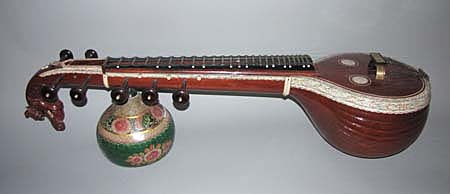
Owner: HWMC
Catalog#: AS-CHLT-06-14
Lutes
India 'Thanjavur' Veena
South India
Dravidan Speaking People (Karnatic Music)
Wood, metal, bone, papier-mâché
Early-Mid 20th century
Length: 54 in; Width: 15 in; Height: 15 in
Chordophones – Lutes
The veena (vina) is the principal indigenous term for chordophones in India and other regions of South Asia. The veena seen here is used in southern Indian Karnatic music and is a polyphonous instrument designed and developed by Govinda Dikshitar during the reign of ‘Raghunath Naik of Tanjore.’ It is often called the Thanjavur (Tanjore) veena or the Saraswati veena. This veena is 54 inches in length comprising a large wooden resonator made from jackfruit wood, a wooden bridge (kudurai), a tapering hollow neck (dandi) made of rosewood, and a small non-functional resonator painted and made from a type of papier-mâché. There are seven strings: four main strings and three talam strings, with seven wooden tuning keys/pegs, and 24 brass frets. The veena is trimmed in bone with a red and green floral design. This Saraswati veena is played while in a seated position, holding the instrument across the lap in a nearly horizontal position. A person who plays the veena is called a vainika.
Resource: “Vina,” Alastair Dick; Gordon Geekie; Richard Widdess; Philippe Bruguiere, “The Grove Dictionary of Musical Instruments,” 2nd ed., Vol. 5, Laurence Liben, Editor in Chief. Oxford University Press.
